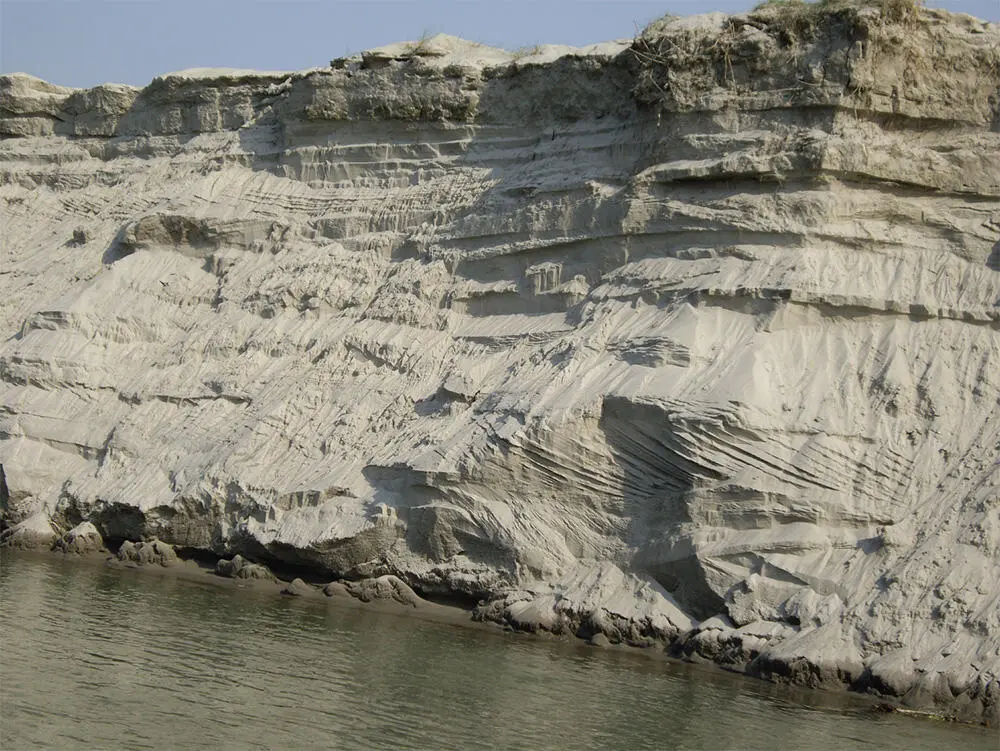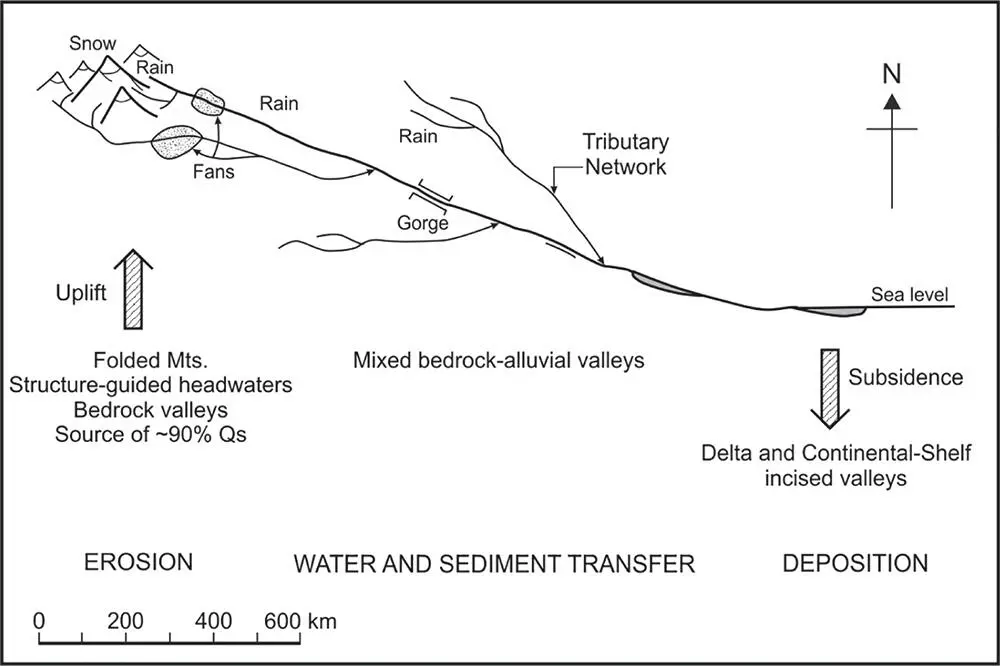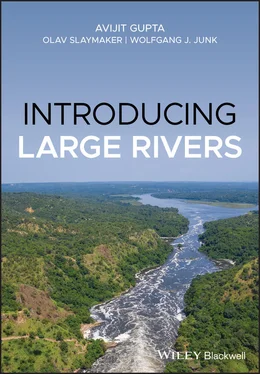32 Syvitski, J.P.M. and Milliman, J.D. (2007). Geology, geography, and humans battle for dominance over the delivery of fluvial sediment to the coastal ocean. Journal of Geology 115: 1–19.
33 Wasson, R.J., Olive, L.L., and Rosewall, C.J. (1996). Rates of erosion and sediment transport in Australia. IAHS Publication 236: 139–148.
34 Wohl, E.E. (2007). Hydrology and discharge. In: Large Rivers: Geomorphology and Management (ed. A. Gupta), 29–44. Chichester: Wiley.
35 Woodward, J.C., Macklin, M.G., Krom, M.D., and Williams, M.A.J. (2007). The Nile: evolution, Quaternary river environments and material fluxes. In: Large Rivers: Geomorphology and Management (ed. A. Gupta), 261–292. Chichester: Wiley.
36 Xu, K.H., Milliman, J.D., Yang, Z., and Xu, H. (2007). Climatic and anthropogenic impacts on water and sediment discharges from the Yangtze River (Changjiang), 1950–2005. In: Large Rivers: Geomorphology and Management (ed. A. Gupta), 609–626. Chichester: Wiley.
4 Morphology of Large Rivers
4.1 Introduction
What are the characteristics of a large river? Meade (2007) has described large rivers as ‘massive convenience systems for moving detrital sediment and dissolved matter across transcontinental distances’. This implies a very long river, say 1000 km or longer, that carries a huge volume of water and a large sediment load of several types from the land to the sea.
Many smaller rivers have been studied in detail but only a limited number of large rivers. The biggest, the Amazon, has been observed in detail (Junk 1997; Dunne et al. 1998; Mertes and Dunne 2007), and also several others, particularly the Mississippi (Knox 2007 and references therein). Detailed morphological descriptions and relevant hydrologic and sedimentological data, however, are not available for all. We know a lot less about certain rivers such as the Congo or Salween.
This raises several questions. Is there a continuum among rivers of different size, i.e. does a scale invariance in form and behaviour exist between small and large rivers or do large rivers have special properties? Do large rivers, immense in form and complicated in function, record evidence of crustal deformation, hard rock erosion, and water and sediment fluxes over long time periods, as Mertes and Dunne (2007) have shown for the Amazon, which could not be studied in smaller streams? Does the presence of a large river imply a geological history and a climatic condition as described in Chapters 2and 3of this book? Do large rivers last longer than streams of smaller dimensions? Do the effects of sea-level changes remain recorded in detail over a long stretch of the lower section of a continental-scale river because the gradient is very low? Do floods and floodplains play an important role regarding the morphology and ecology of large river valleys? Can huge sedimentary alluvial deposits/bars of large rivers such as the Brahmaputra ( Figure 4.1) be recognised in later sedimentary rocks (Fielding accepted for publication)? In this chapter we explore these and other queries, and describe the general morphology and behaviour of big rivers.
4.2 Large Rivers from Source to Sink
Imagine a large river that rises in a folded mountain range and flows to the sea and has a gentle offshore gradient ( Figure 4.2). The tectonically active mountains of high relief tend to produce large quantities of rock fragments from seismic movements, glaciation, slope failures, and erosion by steep headwaters. The mountainous headwaters of the large river tend to flow in a pattern of deep valleys, are often structure-guided, have steep gradients, and their bed and banks are constituted of coarse sediment and rock. The combination of steep gradient and pulses of high discharge associated with orographic precipitation flush a volume of coarse sediment out of the mountains along river channels. As the rivers exit the mountains, their slopes sharply decrease, causing them to deposit sediment and build triangles of alluvial deposits called fans near the highland-lowland contact ( Box 4.1). These fans mask the sharp contact between the mountains and the plain and reduce the gradient of the river. The large trunk river continues for a long distance beyond the fan, over a gentler gradient. Tributaries join it at intervals across the plain, increasing its discharge and sediment load. Finally, the river flows through a set of deltaic distributaries into the sea.

Figure 4.1 At least 10 m high midchannel bar in the Brahmaputra at Sirajganj, Bangladesh; locally known as the Jamuna. A high volume of sand is moved in the wet season and stored during the dry monsoon. Large-scale sedimentary structures are visible. The top of the bar is at several levels.
Source: Gupta 2007.

Figure 4.2 Schematic network of a large river. Compare with the satellite images of several large river basins: Amazon ( Figures 3.4and 4.5) and Ganga ( Figure 4.7).
This is a short and simplified description. Form, behaviour and sediment of large rivers, however, vary among themselves. Two rivers, the Amazon and Ganga, are described to establish a general picture and several common properties. Several other rivers are then discussed, to highlight an expected assemblage of form and behaviour of large rivers and variations from such expected outcomes. Form and behaviour of a large river is the combined result of such an expected outcome and deviations therefrom.
Box 4.1Rivers on Alluvial Fans
Sediment yield from fold mountains are characteristically very high (e.g. 10 4tkm −2yr −1) (Douglas and Guyot 2005). The nature of the sediment depends on the regional geology which in a tectonic mountain may include material from active subduction zones, collision belts, volcanic arcs, granitic plutons, rift valleys and uplifted sedimentary rocks (Scatena and Gupta 2013). A significant amount of the sediment is deposited at the foot of the mountains to form alluvial fans. The upper Amazon and its tributaries have built very large alluvial fans at the foot of the Andes. There the material derived from the mountains after deposition is stored for a long time (10 2–10 3years), and progressively weathered into a mature sediment enriched in quartz grains before the grains are removed downstream. The sediment of the Amazon River downstream is derived almost entirely from the Andes and these fans. A series of such large alluvial fans extend along fold mountains. The especially large ones are referred to as megafans as they differ from the common alluvial fans by their large size (10 3km 2or greater), low gradient (commonly <0.1°), typical sorted sedimentary texture (boulders at the apex and predominantly silt and mud at toes), and depositional processes (mostly by wandering channels of a single river) (Leier et al. 2005). Megafans are important source of sediment from tectonically active areas in the seasonal tropics ( Figure 4.3).
Emerging from the mountains to the plain, The Ganga and its Himalayan tributaries also have built alluvial megafans. The best known of the Himalayan megafans is that of the Kosi River which covers 154 × 147 km in area, and slope 0.89–0.025 m km −1longitudinally from the Himalayan front to the Ganga River. The climate of the region is affected by the Indian monsoon system. The regional average annual rainfall is between 1300 mm and 1800 mm, 80% of which occurs between June and October. Individual large storms are superimposed on the general rainfall pattern. The Kosi fan consists of large volumes of clastic sediment derived from the Himalaya. On the upper part of the fan, the Kosi River
Читать дальше














